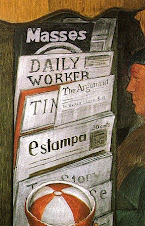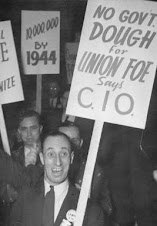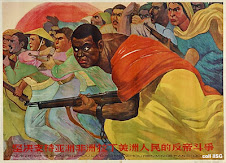Published May 5, 2010 4:48 PM
In Nepal, Honduras, Greece and elsewhere around the world, this year’s May Day actions went far beyond the traditional workers’ holiday by opening major struggles over decisive policies and in some cases over questions of power.
In Istanbul, Turkey, straddling Europe and Asia, hundreds of thousands of workers took over Taksim Square. Dozens of workers died of gunshot wounds when attacked by paramilitary forces at Taksim Square in 1977. Last year the Turkish Parliament declared May Day a holiday once again.
In Palestine, some 2,000 Palestinians protested Israel’s blockade of Gaza and for the right of workers to travel at the Erez crossing into the territory to work.
President Jacob Zuma spoke to a rally in Durban, South Africa, urging unity of the 2-million strong COSATU union confederation, the Communist Party and the ruling African National Congress, and promising to introduce laws to regulate subcontracting and outsourcing.
Anti-NATO slogans joined more traditional ones in Moscow this year, following the unpopular invitation to NATO officers to join the Victory in Europe Day parade on May 8.
Throughout the world, from Africa to the Pacific Islands, from New Zealand to Russia, workers came out with the expected demands in times of deep capitalist economic crisis: end layoffs, stop cutbacks of government services and so on. In some countries, however, the protests surpassed these limits.
Class struggle at the top of the world
In Kathmandu, Nepal, the Maoist-led May Day demonstration of a half-million red-garbed, banner-waving workers and peasants “turned the capital red” and led directly into an indefinite general strike. By May 2 the strike had closed the capital and other major Nepalese cities.
The Maoists — that is, the Unified Communist Party of Nepal, Maoist, led by Pushpa Kamal Dahal Prachanda — have been out of the government for almost a year, although they are the largest single party in Parliament. At the May Day demonstration, Prachanda called for the resignation of the current prime minister and for constitutional change. The Maoists put responsibility on the regime for keeping the struggle peaceful.

As of May 3, the strike and the struggle over government power continue in Nepal. India, the regional big capitalist power, has taken the side of the government against the Maoists, as has U.S. imperialism. The masses of activist Nepalese are with the revolutionaries. While the Maoists have powerful foreign enemies, they also have the experience of 10 years of armed struggle — 1996-2006 — that overturned the Nepalese monarchy.
Elsewhere in Asia, there were marches of textile workers in Dhaka, Bangladesh, and in Phnom Penh, Cambodia, of railroad workers in Rawalpindi and other workers throughout Pakistan, with protests in nearly all Asian countries, including those in Australia. In New Zealand an unprecedented 50,000 people demonstrated to demand no mining of conservation land.
Resistance still strong in Honduras
In Tegucigalpa, Honduras, some 500,000 to 700,000 workers and farmers demonstrated in solidarity with the Resistance Front and against the current Pepe Lobo regime, which they see as a continuation of the coup regime that overthrew Manuel Zelaya last June 28. The march in the capital was the largest of a dozen in the Central American country.
Activists and trade unionists interviewed about the march on YouTube said that “90 percent of the Honduran people are with the resistance.” Since June this resistance has unified all the progressive movements in Honduras against the pro-coup regime. They demand a Constituent Assembly that would be an organ of popular power.
The main obstacles to this people’s power are the Honduran army and the support the U.S. and other imperialist powers give the Lobo regime. The massive May Day protest has shown the tremendous potential of the resistance movement to reverse this balance of power.
In Venezuela, President Hugo Chávez announced a 15 percent increase in the minimum wage this May Day. The May 1 Wall Street Journal headline read: “Venezuela May Day Celebrations Draw Chavez Fans, Opponents.” What it left out was that the opponents numbered 200, while the “fans” were closer to a half million.
President Evo Morales in Bolivia celebrated the day by announcing the nationalization of three power companies and one utility that had been privatized. Elsewhere in South America and the Caribbean, there were more traditional May Day marches, though there were sharp clashes with police and arrests in Chile and Colombia.
One million defend Cuba
The usual massive and enthusiastic May Day march in Havana, Cuba, had a special element this year. In the past few months the imperialist regimes and media not only in Washington but in the European Union have waged a campaign of lies and calumny against the Cuban government and the socialist system on the island.
The imperialists took the anti-socialist writings of one blogger, the suicide of one prisoner — just think of what happens in U.S. prisons in comparison — and the actions of a half dozen “women in white” and blew them all out of proportion.
Thus it was refreshing that once again a million people in Havana, with President Raul Castro presiding, and more in other Cuban cities gathered to show unity against this concerted imperialist attack.
Class struggle in Europe
In Europe, the first sharp test between big capital and the working class is unfolding in Greece, where an European Union-International Monetary Fund loan depends on the Greek government’s forcing severe austerity on the Greek working class. It was no surprise then, that in Athens and Thessaloniki workers were on the move and young anarchists battled police.
The Communist-led unions insist that the rich should pay for the crisis caused by their capitalist system and by the plundering by the financiers, and not the workers. They have held four limited general strikes so far this year, and the struggle over the austerity program is just beginning.
In the West European countries expecting to be next hit by the debt crisis, protests were also strong. Some 90,000 workers marched in Lisbon, Portugal, and another 20,000 in Porto. The mood was combative, according to local observers. In Spain, where official unemployment hovers around 20 percent, there were also street demonstrations.
Articles copyright 1995-2010 Workers World. Verbatim copying and distribution of this entire article is permitted in any medium without royalty provided this notice is preserved.
Workers World, 55 W. 17 St., NY, NY 10011
Email: ww@workers.org
Subscribe wwnews-subscribe@workersworld.net
Support independent news DONATE










































No comments:
Post a Comment